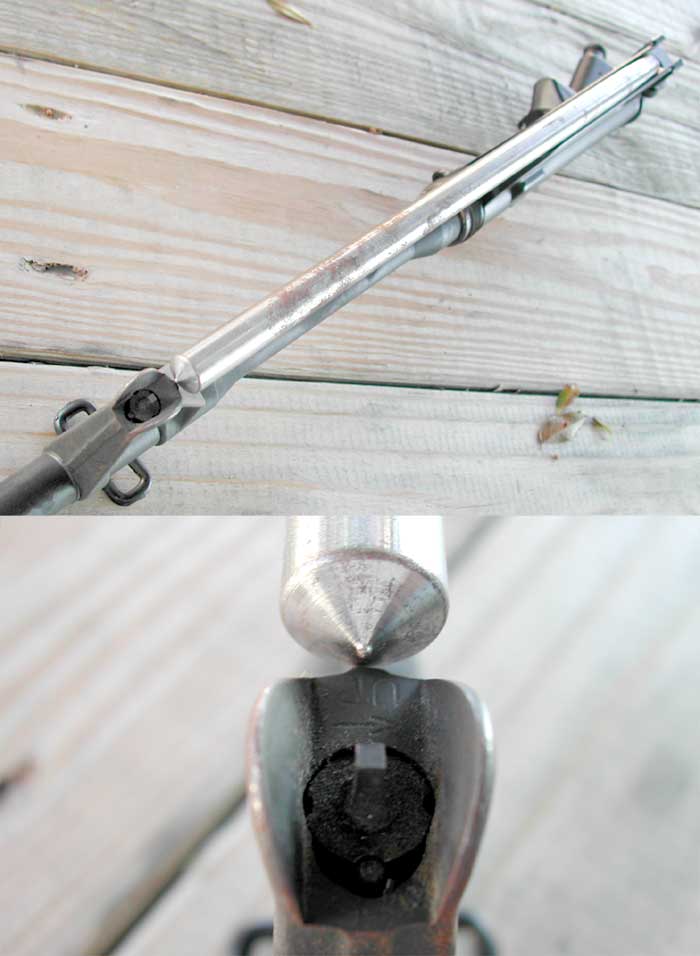|
||||||||||||||||||||||||||||||||||||||
Life is too short to deal with Blonde women, or carbine barrels over 10.5 inches
Ken Elmore can fixture align the FSB to the receiver.
Aubrey<><
My unpleasant and in some cases not-worth-it solution would be to knock out the taper pins, align the FSB, and re-ream the taper pin holes for the next-size-up taper pins. I made a fixture for this in about 1981 and have been using it ever since, and I imagine that Colt has something similar but I would think and hope, better. But I've always felt that that little 1/8 locating pin in the barrel extension, so close to the bore center was just barely adequate(making a situation where a little clearance/movement there translates into a lot of it at the top of the FSB). This same phenomenon means that if the locating pin has, say, a .005 chip or something under it in the fixture as the taper pin holes are drilled and reamed, your FSB is going to be maybe .025 off center / leaned over.
I have not personally seen one where the play between the locating pin and upper receiver was enough to make a canted FSB that one could notice. I have of course seen plenty of AR's that had the rear adjusted a fair amount left or right, but that's why they're adjustable after all. If the guns could be made perfectly every time they could just drill a hole in the upper for a rear sight-- but we all know that ain't gonna happen.
I've gone so far in my early days as making a "key" to replace the locating pin, thinking that the pin could easily move metal in its slot in the upper, but although it still SEEMS to me like it could, I've never seen it happen.
The ideal solution, in those cases where you can, is send it back to the factory. Why do we keep getting guns so far from perfect? Because they send them out and don't get any complaints. I know that's an unpalatable solution-- takes forever, etc...... just saying it's a good way to let them know "we ain't taking this sheisse anymore".
While on the subject, may I add that in my view, the many alternatives to taper pins are.....let's see here..... cheezy attemptsto save an operation (taper pin reaming). Straight dowels are very strong but required a perfectly sized hole-- like plus or minus a tenth of a thou-- to ensure a no-falling-out pin fit. Have seen them falling out, and Loctited and staked them in. We're not supposed to have to do that. Roll pins, also not good. Set screws/clamp screws, well, screws come loose.
Ned,
Thank you for taking the time to respond here.
Could you please share a little more insight in regards to the following statement a little better, as I'm not quite sure I understand what you were explaining here:
"I've gone so far in my early days as making a "key" to replace the locating pin, thinking that the pin could easily move metal in its slot in the upper, but although it still SEEMS to me like it could, I've never seen it happen."
-I don't understand what you mean by a replacement "key" easily "moving metal" ???? What in the world does this mean? Your replacement "key", is obviously replacing the locating pin, which fits in the uppers slot.
However, I'm lost after that. What is the purpose of your key, and what do you mean by it "moving metal"?????
Thanks Ned. SO GREAT to have your comments in this thread as well as all the others...
Picture a piece of steel 1/8 X 1/8 X 3/16 (or so) with a length of 1/8 diameter sticking out of it, it's all one piece. The diameter goes into the hole in the bbl extension and the other part fits in the slot, just giving more bearing area of steel against aluminum in the slot, plus, the key having been sized exactly to the slot to take out any potential play.
A lot of extra work for some theoretical gain that just wasn't worth it.
You can use a simple 1/2" rod with a point on the end like this to check FSB alignment while tightening.
If you have a flattop receiver, you will need to mount a carry handle in order to hold the rod.

Randall Rausch
AR15 Barrel Guru
Thanks Randall,
I was beginning to wonder if that's all the jig consisted of!
Unfortunately, when the bbl is being torqued, the flat top of the receiver is in between an upper vise block and a piece of plywood, in between the jaws of the vise, however, that is an excellent idea for checking when the upper is not down in the vise....
I used to do this (with a big slot screwdriver) exact technique, but found the results inconsistent. I also found, once going to an armorer's class, a properly used torque wrench prevents overtorquing to begin with.
Set your wrench for 30ft/lbs, and once seated the barrel in the upper, tighten until your wrench clicks. You've reached the minimum torque, and then check gas tube alignment. Usually (9 times out of 10), I only need to apply another few foot/pounds in order to index the scallops of the barrel nut. That one time out of ten may require more torque (in which I usually replace the barrel nut) or 30ft/lbs was exactly enough to get the barrel nut indexed.
When test firing at the range, 5 clicks is usually the maximum I have to adjust. Resuts, though, will vary depending on rear sight (some BUISs fit differently on different uppers, and therefore zero differently).
Nemo me impune lacessit
Bookmarks